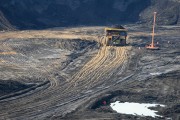There’s a carnival in town, and everyone is talking about its main attraction — the mighty resource rollercoaster that is taking Alberta’s and Canada’s economies for a wild ride. Albertans are already paying a premium at the ticket booth, but few have noticed the fine print on the bottom of the receipt: once the carnival leaves town, ticketholders may be left paying for the cleanup costs.
How we got to the carnival in the first place
Clearly, times could be better for the oilsands industry. Profits are being pinched at one end by rising capital and operating costs and at the other end by lower than expected market prices for oilsands crude. This financial struggle is not limited to oilsands companies and their financiers — as oilsands development grows, government coffers are also feeling the pain of dissolving revenue.
 Alberta received $6 billion dollars less than expected from the oil and gas industry in 2012. The 2013 federal budget indicated that it would have received $4 billion more if Canadian oil and gas were trading at world prices. The solution: pipelines. If you can reach tidewater, you can sell your product to other markets that will pay more.
Alberta received $6 billion dollars less than expected from the oil and gas industry in 2012. The 2013 federal budget indicated that it would have received $4 billion more if Canadian oil and gas were trading at world prices. The solution: pipelines. If you can reach tidewater, you can sell your product to other markets that will pay more.
Unfortunately, you cannot pipe your way to financial security. Having access to world oil and gas prices will not solve all the public or private sector revenue woes − especially when global prices are volatile, which is only aggravated by geopolitical shocks and natural disasters. Think the Arab Spring, Venezuela or Hurricane Rita, which hit the world’s largest refining complex along the U.S. Gulf Coast in 2005.
Financial curveballs happen to everyone. That’s why there is insurance: to minimize acute financial risks by spreading the costs over time. Homeowners have insurance in case a tree falls on their roof and oil companies have insurance in case they have an oil spill.
What happens after the carnival leaves town?
The biggest financial risk facing Alberta taxpayers is what happens if the oilsands industry is no longer economically viable and oilsands companies leave Alberta with a damaged economy and a very expensive cleanup bill. (Now there are many ways to lessen the public sector’s dependency on oilsands revenue, which I will write more blog posts about this spring and which are mentioned in a report I co-authored last year, In the Shadow of the Boom.)
For now, let’s take a look at what kind of insurance the Government of Alberta has, in case an oilsands mining operation fails to reclaim its mine site.
Understanding Alberta’s oilsands reclamation insurance policy
The Mine Financial Security Program (MFSP) is Alberta’s main tool to ensure that taxpayers are not on the hook for reclamation costs, and we’re not talking chump change. Oilsands mine reclamation liabilities in 2008 were estimated at up to $15 billion dollars — and the industry, along with the liabilities, has grown rapidly since.
Created in 2011, the MFSP uses a basic asset to liability approach. The value of the bitumen in the ground is used as collateral for any reclamation liabilities that are created. If a company crosses a certain threshold of assets to liabilities, then the Province requires the company to submit essentially a cash deposit. As I explained in a previous blog post, considering this is Alberta’s insurance policy for a worst-case scenario, the MFSP is highly exposed to the risk of a collapse of the oilsands mining industry.
Most insurance is based on non-correlated risk. In other words, not all insurance holders have the same medical conditions or get into an accident at the same time. So over time, Peter pays Paul and Paul pays Peter. The problem for oilsands mines is that the risk is much more likely to be correlated. Both Peter and Paul would need to be paid at the same time. Like a natural disaster, an extreme economic downturn or rapid shift to alternate crude or energy sources would affect the economic viability of all of the mines at the same time — and leave the public holding the multi-billion-dollar bag.
Meanwhile, the past is a poor predictor of future reclamation costs. As public expectations of reclamation are rising, so too will reclamation costs. The province needs to have a policy that can afford to pay for reclamation for all of the mines.
The idea that the oilsands industry as a whole could collapse is not inconceivable. David Emerson, the former Conservative cabinet minister who led the 2011 report of the Premier’s Council for Economic Strategy, warned that “…we [Alberta] must plan for the eventuality that oil sands production will almost certainly be displaced at some point in the future by lower-cost and/or lower-emission alternatives. We may have heavy oil to sell, but few or no profitable markets wishing to buy.” Alberta must plan for the eventuality that oil sands production will almost certainly be displaced at some point in the future by lower-cost and/or lower-emission alternatives...
— David Emerson
As I mentioned earlier, the volatility of global oil prices, significant capital and operating cost increases, rapidly rising social expectations of reclamation, and the off-the-balance sheet carbon liabilities should give a clear signal to Alberta to have a catastrophic insurance policy that is extremely risk averse and very transparent.
Ticketholders are starting to read the fine print
A growing number of diverse voices are raising concerns about how Alberta is handling reclamation liabilities. While the Auditor General of Alberta has yet to assess the MFSP, that office has had longstanding concerns about the adequacy of the province’s reclamation liability management policies dating back to 1999. In October 2012, a coalition of investors with $2 trillion in assets under management, wrote a report that highlighted, among other things, their concerns over the disclosure of reclamation liabilities and the poor reclamation performance of the industry. More recently, Wildrose MLA and Opposition Environment Critic Joe Anglin questioned provincial officials over the adequacy of the MFSP’s asset to liability approach to cover reclamation costs.
Plan ahead now, or pay later
A December 2012 ruling by the Supreme Court of Canada sheds some light on the ability for provinces to recoup reclamation costs if a company becomes insolvent. AbitibiBowater, a large Newfoundland-based pulp and paper manufacturer filed for bankruptcy protection in 2009 before the Government of Newfoundland and Labrador was able force the company to clean up their polluted mill sites. The province argued to the Supreme Court that they should have priority over other creditors to what was left of the company’s assets. While the ruling upheld the polluter pays principle, it stated that the province has to wait in line with the other creditors — a move that “…certainly heartened the creditor community and disheartened the regulator community,” according to Karen Fellowes, a bankruptcy lawyer in Davis LLP’s Calgary office. This ruling underscores the need for the Alberta Government to have a robust reclamation liability management scheme in place when a company is solvent.
The federal government (read: Canadian taxpayers) is on the hook for billions of dollars in liabilities from unreclaimed industrial sites across the country. One of the most notorious has been the Giant Mine near Yellowknife, Northwest Territories. Documents recently obtained by the Canadian Press estimate that the cleanup bill for that single mine is nearly $1 billion, more than double initial estimates. Ensuring that mines have adequate contingency funds or that governments have sufficient reclamation insurance is crucial for avoiding the financial burden of cleanup falling on taxpayers.
Alberta is reviewing its reclamation insurance policy
According to government sources, Alberta currently is meeting behind closed doors with oilsands mine operators to review the adequacy of MFSP and see if there are any areas where the program can be improved. It is unlikely that industry will have major issues with the MFSP, which was the result of a six-year private negotiation between Alberta and those same companies. The resultant MFSP freed up much-needed cash for industry, and no longer required companies to offer financial assurances as the liabilities were created.
Unfortunately there is no formal method for public consultation or invitation for the public to submit comments for this review. Even so, the Pembina Institute approached Alberta Environment and Sustainable Resource Development (AESRD) and secured the opportunity to submit comments and policy recommendations that we hope will help inform the MFSP review.
Our feedback to AESRD stressed the need for greater risk aversion by requiring full financial security as land disturbance occurs. We also emphasized the need for further transparency and accountability of the MFSP. The letter also included the recommendations from a report that the Oil Sands Research and Information Network (OSRIN) commissioned Pembina to write on the adequacy of using non-published self-reporting of reclamation liabilities in the MFSP and from a 2010 Pembina report on oilsands mine reclamation liability management.
A poll conducted for industry in June 2010 found that 96 per cent of Albertans want oilsands companies to be liable for all environmental damages caused by their operations. This nearly unanimous public value needs to be the foundation for how reclamation liabilities are managed in Alberta. In 50 years, society’s expectations on environmental stewardship are likely to be much higher than they are today, and less tolerant of pollution risks. Policies like the MFSP need to anticipate and accommodate these changes in public opinion.
By strengthening the Mine Financial Security Program, the province can also reduce the financial risks to the Alberta Treasury, Alberta taxpayers and investors by providing a strong signal encouraging oilsands companies to improve reclamation performance. The province could also make significant strides by improving the disclosure and accuracy of reclamation liability accounting. These changes would have the additional benefit of addressing long-held stakeholder concerns and putting the industry on a better track to earn its social license to operate.
Times could be better for the oilsands industry and Alberta, but times could also be much worse. A strong, risk-averse reclamation insurance policy for the province provides a critical foundation for responsible oilsands development.










